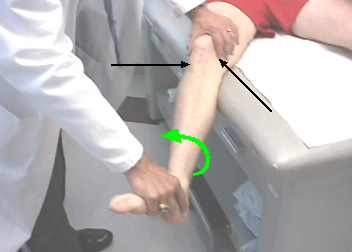
Dial test
The Dial test is performed with the knee flexed at 30 degrees, over the edge of the examining table or with the patient prone. One hand is used to stabilize the distal femur while the other is used to externally rotate the foot. An increased amount of external rotation compared to the contralateral normal knee, is indicative of a posterolateral knee injury.

Rotational laxity can be graded by the increase in external rotation compared to the contralateral knee.
The test may be repeated at 90 degrees of flexion and if the PCL is intact the additional external rotation is less that was seen at 30 degrees as the PCL offers the majority of rotational stability at this angle. Obviously if the PCL is ruptured there will be even more external rotation.
© Mr Gavin Holt :: CotswoldClinics.com :: Print this frame